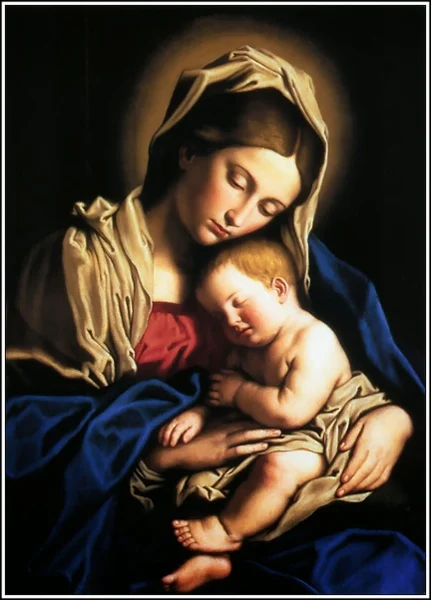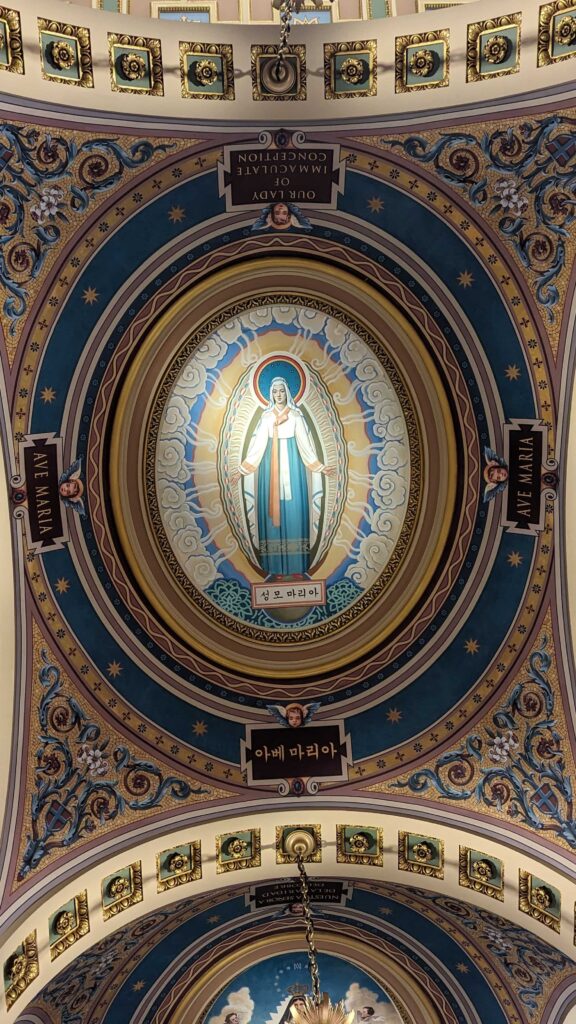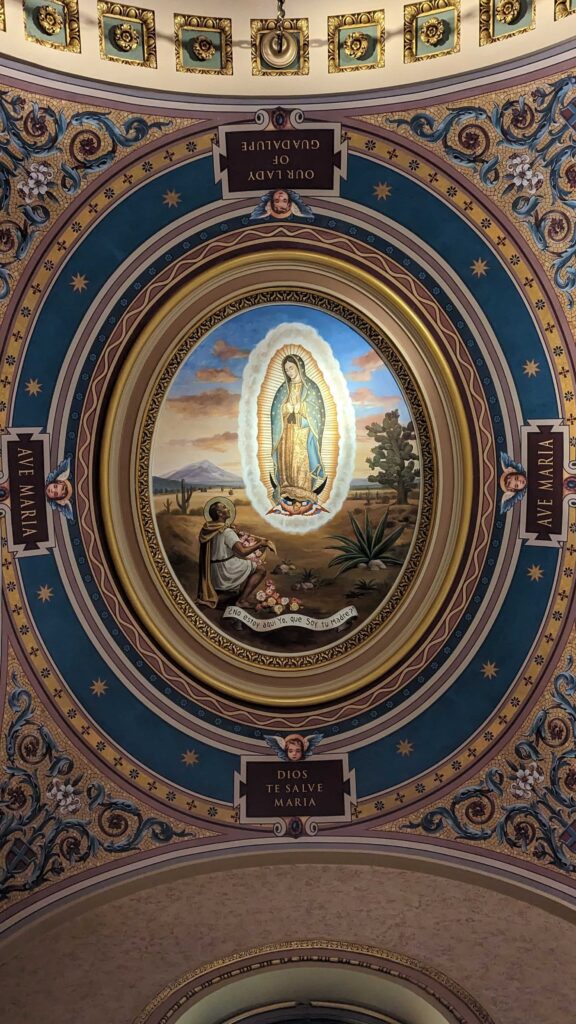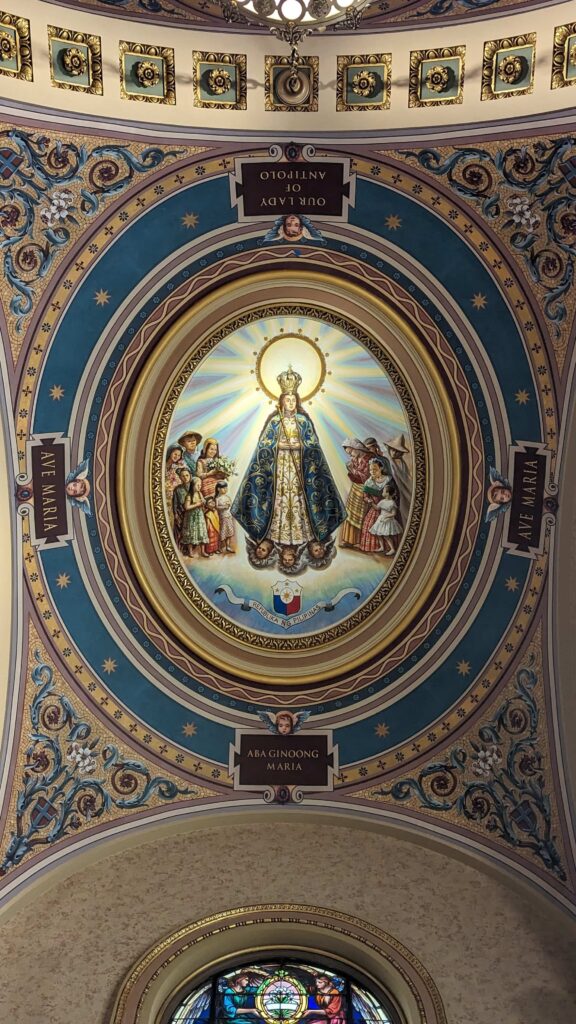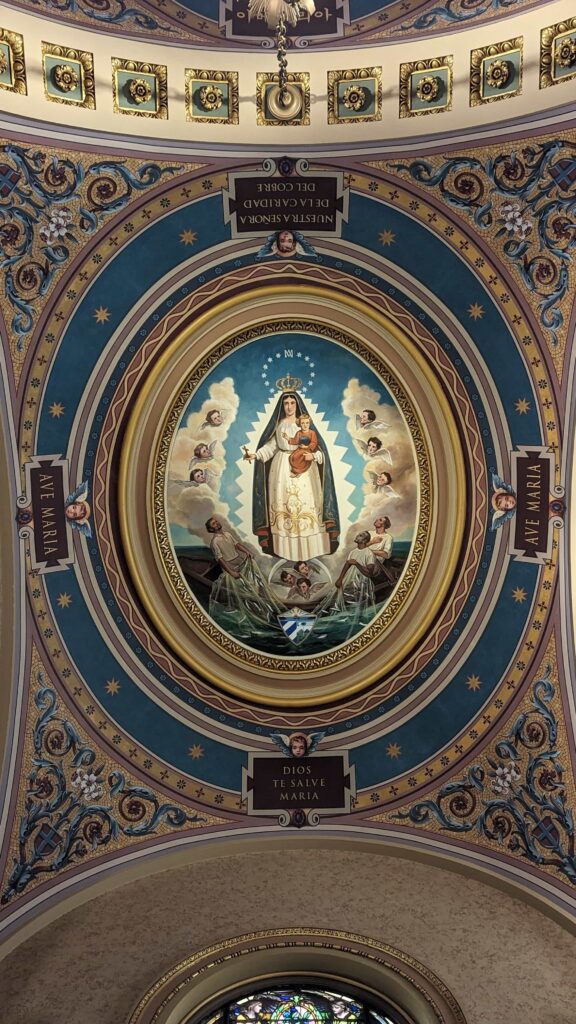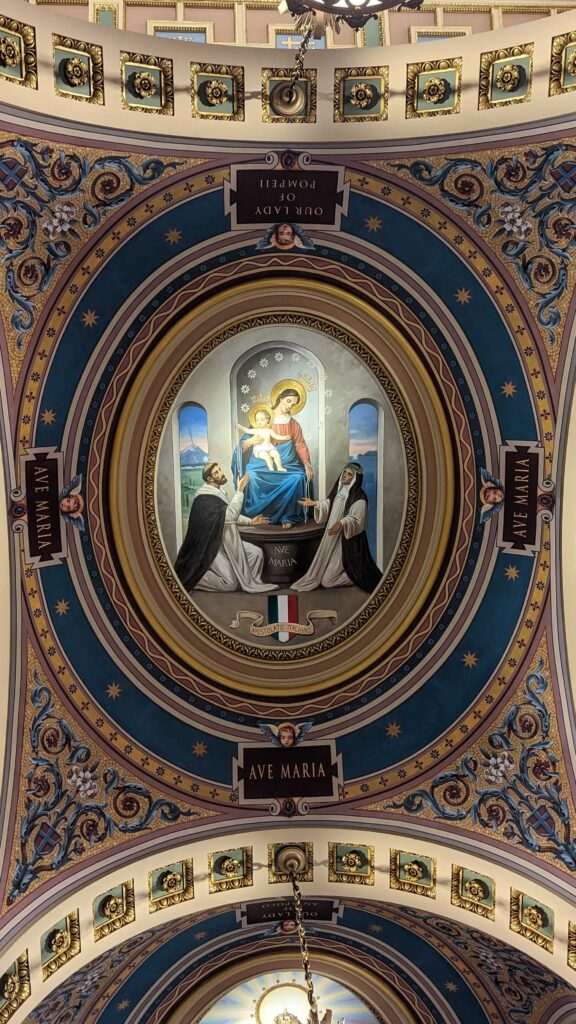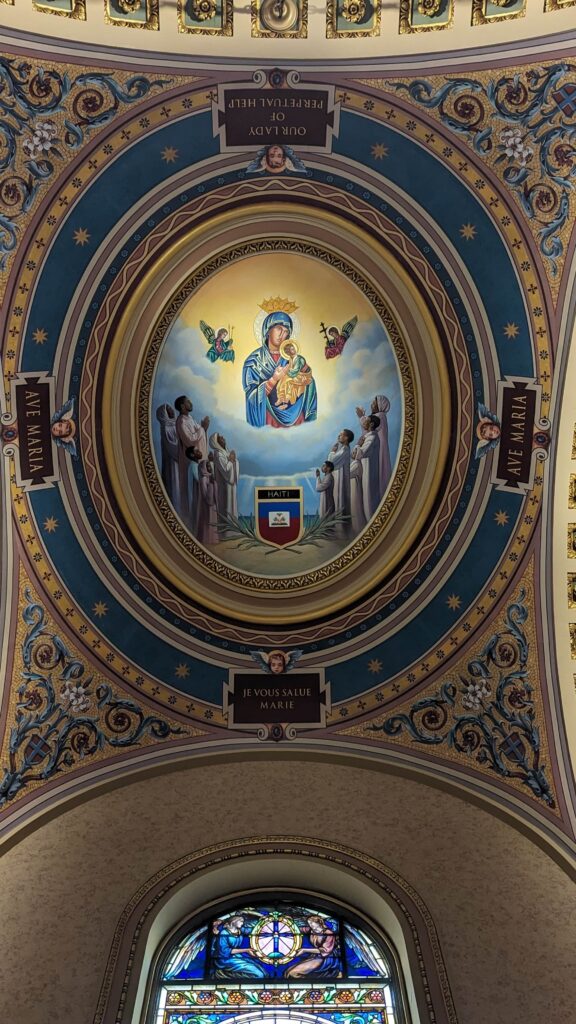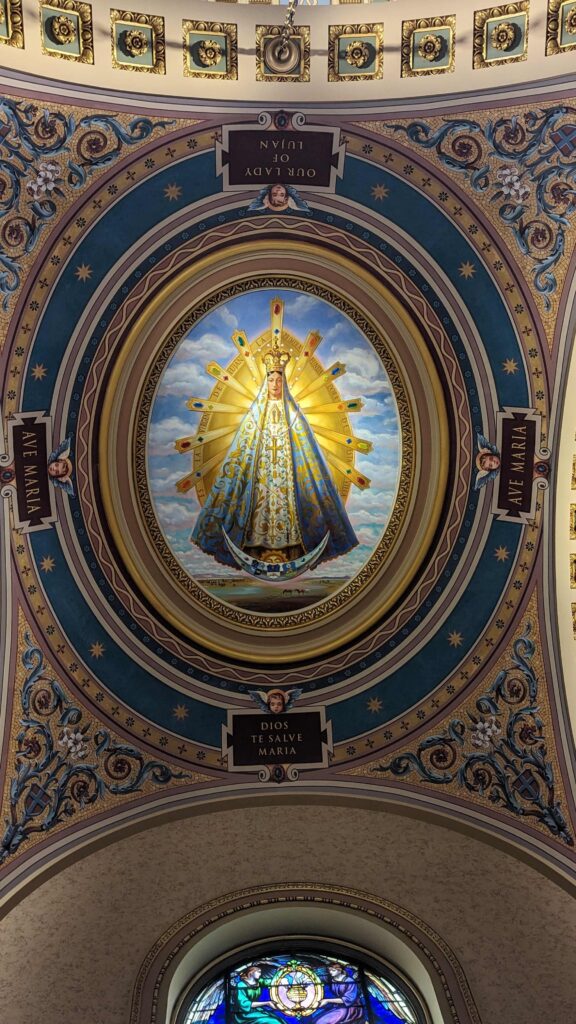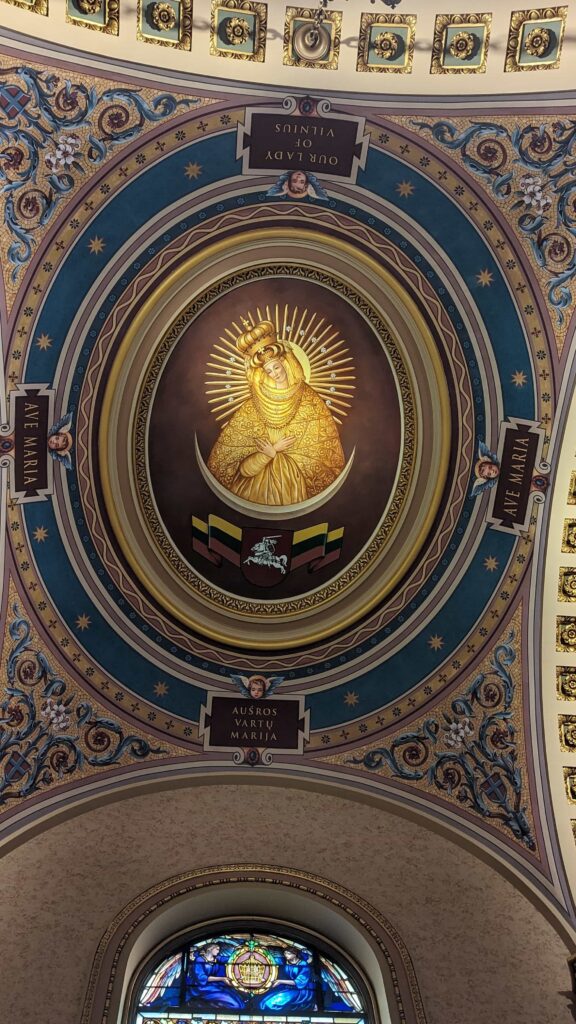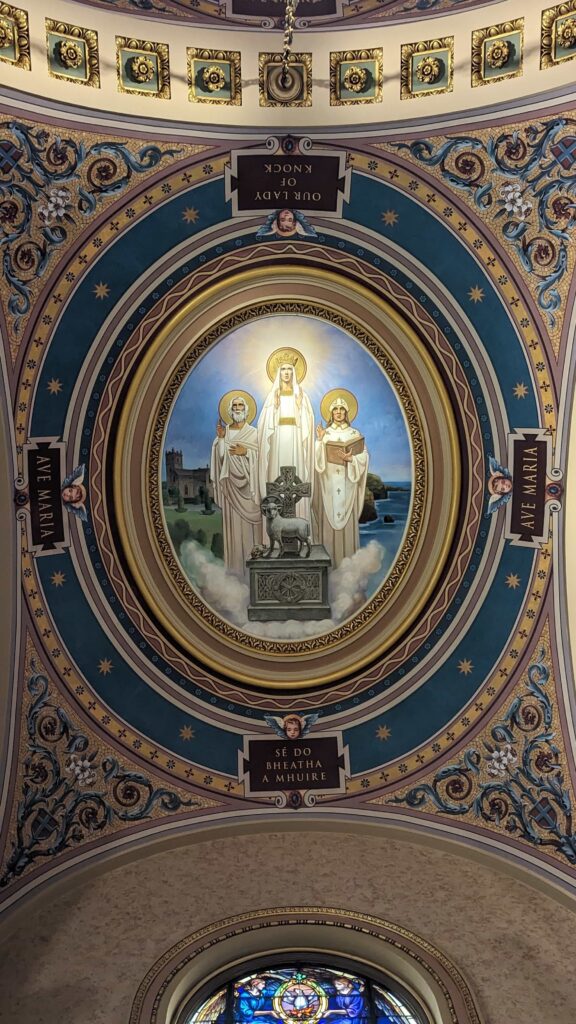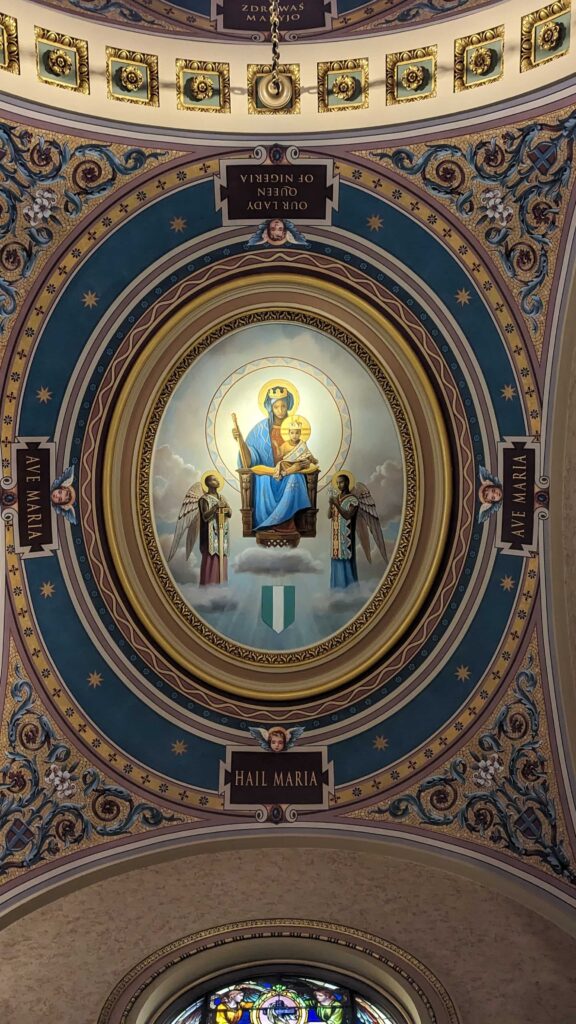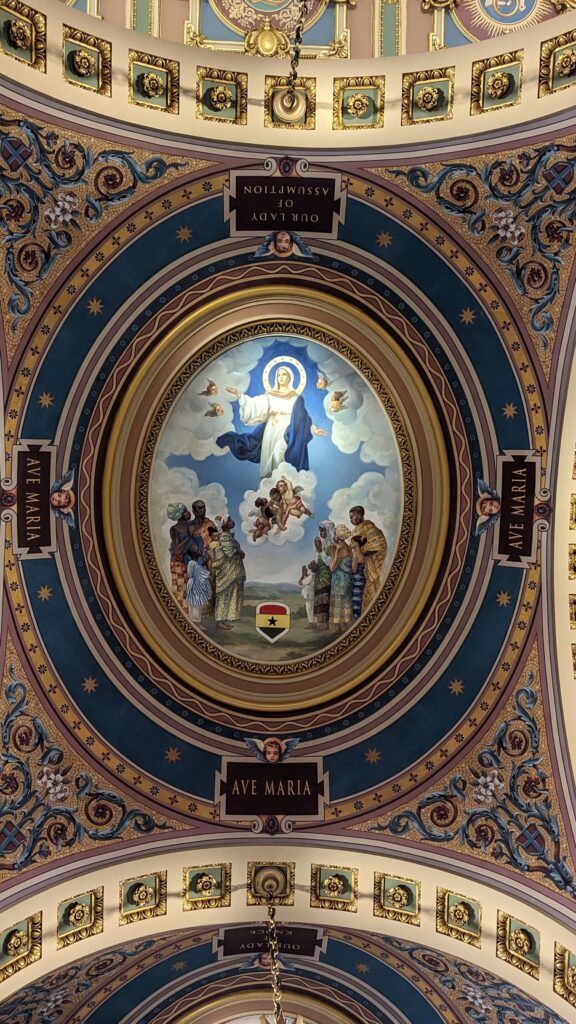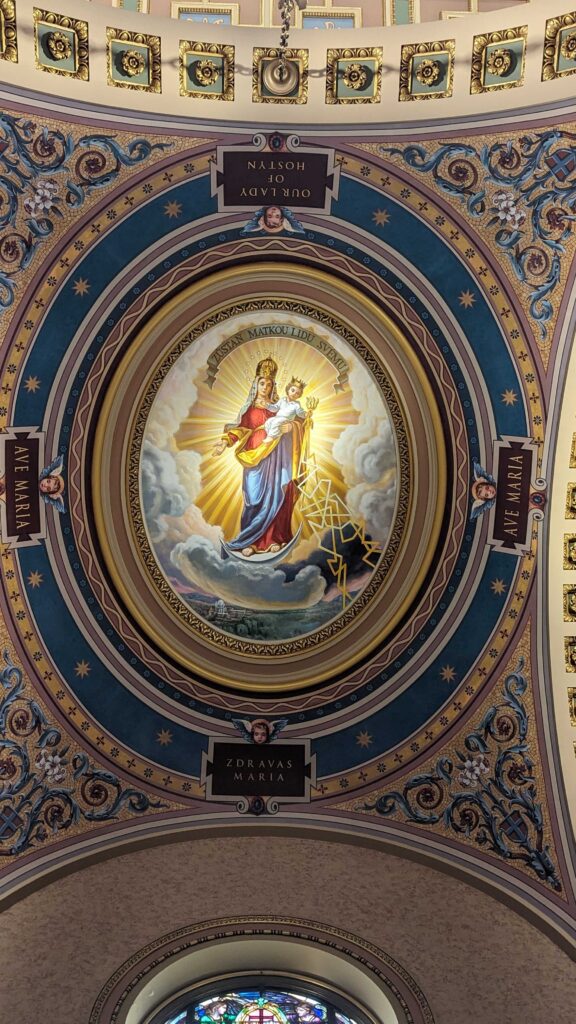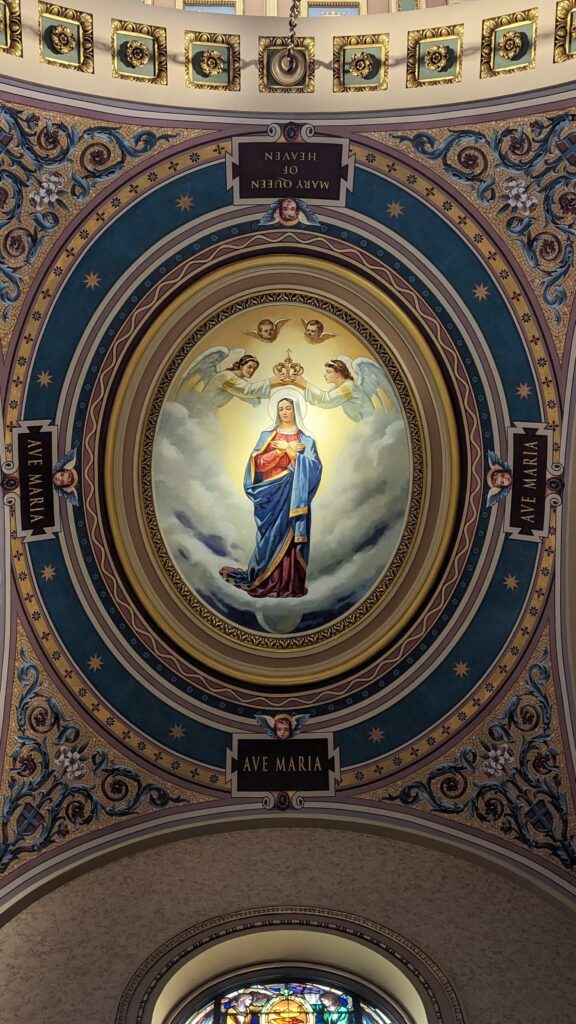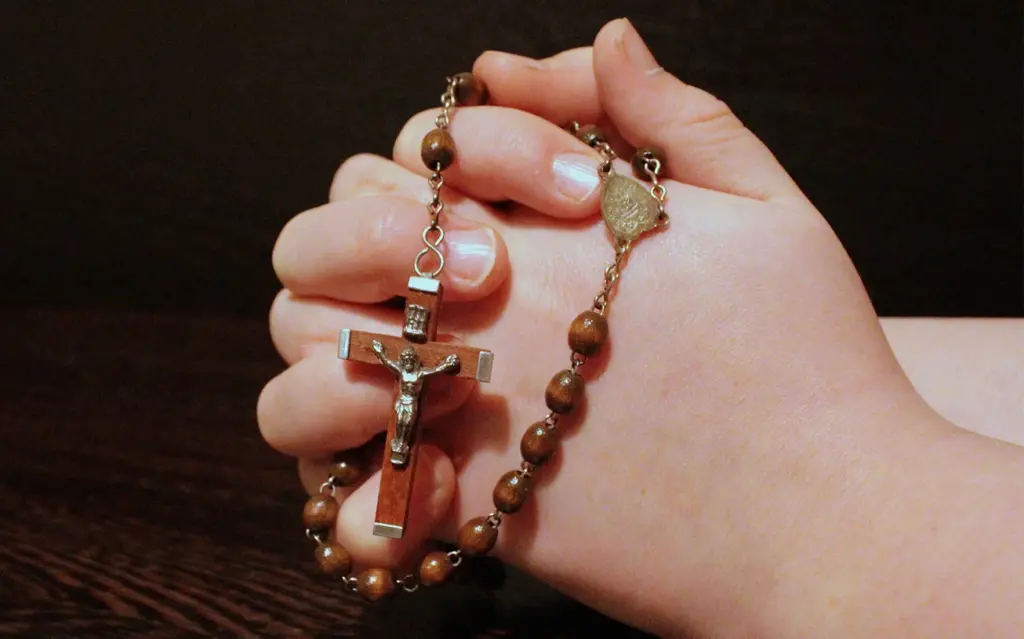In any Catholic church, many Catholic households, and even businesses, you will find devotion and art dedicated to The Virgin Mary.
Despite this visible presence, many people have questions. “Why is Mary celebrated so much?” “What are apparitions?” “What’s a devotion?” Other people are asking “How can I spread devotion to Mary?”
This page is meant to give a quick answer to all of those questions. While there’s far too much to say about her on one page, this is meant to get you started.
Frequently Asked Questions About The Blessed Mother
Whether you’re curious about Mary yourself, or looking to express your own devotion to someone else in a better way, here are a few answers to common questions.
How was Mary the Mother of God?
The first, and most obvious reason why The Virgin Mary is so important is because she was chosen to be the Mother of God. As a virgin, she gave the second person of the Trinity a physical body, nurtured him as a baby, and raised him. Since Jesus is fully God and fully man, the title “Mother of God” is an accurate statement. And a mortal giving birth to an eternal being is still an unfathomable miracle.
When the woman in the crowd touched the hem of Jesus’s garment, she was healed of a hemorrhage that doctors could not heal. If touching the hem of Our Lord’s garment could do that to a person who had faith in Jesus, what would carrying Our Lord in your womb for nine months do? What would living with Jesus, caring for him, holding him, and loving him for thirty years after that?
(For more information, see Catechism of the Catholic Church, 487-507)
Why Is Mary celebrated so much?
Throughout the Old and New Testament, incredibly important faith leaders stumbled. Almost everyone fell short at some point when it came to faith. Adam and Eve, Jacob, Moses & Aaron, Joshua, Samson, King David, King Solomon, and more. Abraham trusted God fully, and thus was chosen to be the father of Israel. In the New Testament, when Mary is told by an angel that she will give birth to Jesus, she responds without an ounce of doubt. Instead, she only rejoices in being chosen to do God’s will.
“Behold, I am the handmaid of the Lord. May it be done to me according to your word.”
(Luke 1:38, NABRE.)
Later in the Gospels, when Christ is preaching and a woman calls out “Blessed is the womb that carried you and the breasts at which you nursed.” He replied, “Rather, blessed are those who hear the word of God and observe it.”(Luke 11:27-28, NABRE).
Not only does this tell us what makes someone great in the eyes of God, it tells us why Mary was so important to begin with. From the example of her perfect faith in God, we learn how to have Faith.
(For more information, see Catechism of the Catholic Church, 971)
Why do Catholics pray to Mary?
Catholics believe that the saints are alive because they are with God in heaven. Since Mary has had the greatest Faith, she is the greatest saint who we ask to pray for and with us. In the Wedding At Cana, Mary saw the bride and groom were in need, and she spoke to Jesus on their behalf. We do the same when we pray to Mary and the saints, we ask for them to pray for us and with us to God.
We understand her intercessory role that she exercises from two perspectives: 1) her being our mother; and 2) from the perspective of the place Mary holds in the Mystical Body of Christ, the neck. Jesus is the Head, and Mary is the neck of the mystical body of Christ. All that comes from Christ flows through the neck, hence Mary’s role as mediatrix of all graces, to the rest of the body. And, all that the rest of the body offers to the Son come to Him through the neck, Mary. Hence, the expression of St. Louis de Monteforte: “To Jesus, through Mary” and the reciprocal is true to: “From Jesus, through Mary”.
(For more information, see Catechism of the Catholic Church, 964-970)
How is Mary our mother?
Jesus died on the cross to pay the debt of sin. We who accept Jesus as their Lord and Savior, are baptized, and receive his sacraments now have the eternal life of Christ within us. Jesus saw fit to share all of his inheritance with us, including the love of his mother and foster father. At the foot of the cross, he said to Mary and John “Woman behold thy son. Son, behold thy mother.” After the crucifixion, the disciples took care of Mary as they would their own mother, and Mary loved the disciples as her own sons and daughters because they were all one family in Christ.
(For more information, see Catechism of the Catholic Church, 964-970)
How was Mary conceived without sin?
God saved Mary from original sin before she was born. A lifeguard could save someone from drowning by jumping into water to get them, or by catching someone who was about to fall into the water. Because Christ needed to be the perfect sacrifice, Mary had to be conceived without sin.
Considering the sacrifice of Christ upon the Cross, a sacrifice that had to be of a perfect, unblemished human nature to pay the debt of all sin: past, present, and future. Thus, Mary was immaculately conceived so she could offer her perfect humanity to the Second Person of the Trinity to become the sacrificial offering. It is from this foundation that we come to understand Mary’s motherhood and therefore the fact that Mary was essential to God’s plan for our salvation.
(For more information, see Catechism of the Catholic Church, 490-493)
The Virgin Mary’s Importance Across Cultures
Across the diocese and the world, Mary has been the symbol of perfect faith in God. On top of that powerful imagery, visions of Jesus or Mary have shaped cultures, and the course of the Church. Many nations have even taken on a particular apparition as the patroness of their country. Mary, apparitions, and devotions have shaped the lives of our community. Each culture treasuring a special devotion, now active in our diocese. The ceiling of The Co-Cathedral of St. Joseph features twenty Marian apparitions and devotions that have deep significance to cultures that now make up the Diocese of Brooklyn and Queens.
The Immaculate Conception (USA, Korea, & The Philippines)
The Immaculate Conception is the belief that Mary was saved by God from original sin before her conception, in anticipation of her role as the mother of Jesus Christ. The doctrine was officially defined by Pope Pius IX in 1854, though the belief has roots in early Christian tradition. It emphasizes Mary’s unique holiness and purity, making her a fitting vessel for bearing the Son of God.
Mary of the Immaculate Conception is the patroness of America, and patroness of the Philippines, Brazil, and Korea; which are all very active cultural groups in our diverse diocese.
Our Lady of Guadalupe (Mexico & The Americas)
The Virgin of Guadalupe was a series of Marian apparitions to St. Juan Diego and his uncle. The story goes that she instructed Juan Diego to build a church at the site of the apparition. To convince the local bishop of her appearance, she left her image imprinted on Juan Diego’s cloak, known as a “tilma.”
The image on the tilma, which still exists today and is housed in the Basilica of Our Lady of Guadalupe in Mexico City, is revered by Catholics as a symbol of Mary’s presence and significance in Mexico and beyond. Our Lady of Guadalupe is the patroness of the Americas and Latin America.
Our Lady of Peace & Good Voyage (Philippines)
Our Lady of Peace and Good Voyage is a revered Marian image in the Philippines, particularly associated with Antipolo City. The image is housed in the Antipolo Cathedral, also known as the National Shrine of Our Lady of Peace and Good Voyage. It is believed to have miraculous powers and is venerated by many Filipino Catholics, especially those seeking safe journeys and protection.
The devotion to Our Lady of Peace and Good Voyage has deep historical roots, dating back to the Spanish colonial period. Pilgrims from all over the country flock to Antipolo to pay homage to the image, especially during the annual pilgrimage season in May.
Our Lady of Charity of El Cobre (Cuba)
Our Lady of Charity, also known as La Virgen de la Caridad del Cobre or simply “Cachita,” is the patroness of Cuba. The devotion to her dates back to the 16th century when her statue was discovered by three fishermen off the coast of Cuba. The image of Our Lady of Charity is housed in the Sanctuary of El Cobre, located near Santiago de Cuba.
She is revered by Cubans of all backgrounds and is considered a symbol of unity and hope. Her feast day is celebrated on September 8th, and pilgrims from across Cuba and beyond visit her shrine to seek her intercession for various needs, including protection, healing, and guidance. Our Lady of Charity holds a special place in Cuban culture and spirituality, with her influence extending beyond the religious sphere into art, music, and literature.
Our Lady of Pompei (Italy)
Layers of history are behind Our Lady of Pompei. Blessed Bartolo Longo, an ex-satanic priest, was saved by God through the rosary. After his conversion, he devoted himself to taking care of the poor of Pompei, spreading the rosary, and created a shrine to Our Lady, including the painting of the Virgin Mary gifting the rosary to Sts. Dominic and Catherine of Siena.
The shrine became a popular pilgrimage site where people came to seek Mary’s intercession for various intentions, including healing, protection, and spiritual guidance.
Today, Our Lady of Pompei continues to be venerated by Catholics worldwide, and remains a significant pilgrimage destination. The devotion underscores Mary’s role as a compassionate intercessor and helper to Christians in their spiritual journey.
Our Lady of Altagracia (Dominican Republic)
Our Lady of Altagracia is a revered Marian title and devotion in the Dominican Republic. The devotion traces its origins back to the 16th century when a painting of the Virgin Mary, believed to be miraculous, was discovered in the town of Higüey. The image depicts Mary and the infant Jesus and is known for its serene expression.
Our Lady of Altagracia is considered the patroness of the Dominican Republic, and her feast day is celebrated on January 21st. The Basilica of Our Lady of Altagracia, located in Higüey, is a major pilgrimage site where thousands of devotees gather annually to honor Mary and seek her intercession for various needs, including health, protection, and blessings for their families.
The devotion to Our Lady of Altagracia holds significant cultural and religious importance in the Dominican Republic, symbolizing Mary’s maternal care and compassion for all her children.
Our Lady of Perpetual Help (Haiti)
Our Lady of Perpetual Help is a widely venerated Marian title within the Catholic Church. The devotion is centered around an icon depicting the Blessed Virgin Mary holding the child Jesus, with angels presenting symbols of the Passion. It’s believed to be of Byzantine origin, dating back to the 15th century, and has been associated with various miracles and answered prayers.
Our Lady of Perpetual Help holds particular significance due to the strong presence of Catholicism in Haitian culture. The devotion to Our Lady of Perpetual Help is embraced by many Haitian Catholics who seek Mary’s intercession for assistance in their daily lives, particularly in times of hardship and suffering. The iconography and prayers associated with Our Lady of Perpetual Help resonate deeply with Haitian Catholics, providing comfort and hope in the face of adversity.
Our Lady of Lujan (Argentina)
Our Lady of Luján is a revered Marian title and devotion in Argentina, deeply embedded in the country’s Catholic identity. The devotion originated from a small terracotta statue of the Virgin Mary, which was brought to Argentina from Brazil in the early 17th century by a Portuguese settler. Legend has it that while traveling, the cart carrying the statue became stuck in the mud near the town of Luján. Despite efforts to move it, the cart remained immobile until the statue was removed, leading the settlers to interpret this as a sign that Mary wished to stay in Luján. A chapel was built to house the statue, which eventually became the Basilica of Our Lady of Luján.
Our Lady of Luján is considered the patroness of Argentina and is venerated by millions of Catholics across the country. The devotion to Our Lady of Luján is deeply intertwined with Argentina’s history and culture, symbolizing Mary’s maternal care and protection over the nation. Her feast day is celebrated on May 8th. The basilica in Luján is a major pilgrimage site, attracting devotees from all over Argentina and beyond, who come to pray for Mary’s intercession in their lives, seek healing, and express their gratitude.
Our Lady of the Gate of Dawn (Lithuania)
Our Lady Gate of the Dawn, also known as the Blessed Virgin Mary of the Gate of Dawn, is a revered Marian icon in Lithuania. The icon is housed in the Gate of Dawn, a historical city gate in Vilnius, the capital of Lithuania.
The devotion to Our Lady Gate of the Dawn dates back to the 16th century when Lithuania was part of the Polish-Lithuanian Commonwealth. The icon is believed to have miraculous powers and is venerated by Catholics as well as Orthodox and other Christian denominations.
The Gate of Dawn became a major pilgrimage site, attracting devotees from across Lithuania and beyond who come to pray before the icon and seek Mary’s intercession for various needs, including healing, protection, and spiritual guidance.
The devotion to Our Lady Gate of the Dawn is deeply ingrained in Lithuanian culture and history, symbolizing Mary’s role as a protector and intercessor for the people of Lithuania. The icon is also considered a national treasure and an important symbol of faith and unity for the Lithuanian people.
Our Lady of Mount Carmel (The Levant)
Our Lady of Mount Carmel has strong ties to the Levant region, (Including Israel, Palestine, Jordan, Lebanon, and Syria.) The devotion to Our Lady of Mount Carmel traces its origins to the Carmelite Order, a religious order that has historical roots in the Holy Land. Our Lady of Mount Carmel comes from the Carmelite Order, an ancient middle eastern religious community who originally inhabited Mount Carmel (Haifa) who dedicated themselves to a life of prayer and contemplation.
The devotion to Our Lady of Mount Carmel grew within the Carmelite Order, and Mary was venerated under this title as the patroness and protector of the order. The brown scapular, a garment associated with the devotion to Our Lady of Mount Carmel, became a symbol of Mary’s maternal care and the wearer’s commitment to living a life of faith and devotion. Many miracles have been attributed to the brown scapular.
The devotion to Our Lady of Mount Carmel spread beyond the Carmelite Order and became popular among Catholics in the Levant region and around the world. Today, Our Lady of Mount Carmel is venerated in churches and shrines throughout the world.
Our Lady of Knock (Ireland)
Our Lady of Knock is a Marian apparition that occurred on August 21, 1879, in the village of Knock, County Mayo, Ireland. According to 15 witnesses, the Virgin Mary, along with Saint Joseph, Saint John the Evangelist, and a lamb on an altar, appeared on the gable wall of the local parish church.
During the apparition, the figures were described as silent and bathed in heavenly light. The event lasted for about two hours, and witnesses reported feelings of peace and awe in the presence of the apparition. Although no words were spoken during the apparition, it was interpreted by many as a message of hope and comfort during a time of economic hardship and social unrest in Ireland. The feast of Our Lady of Knock is celebrated on August 21st, commemorating the anniversary of the apparition.
Our Lady Queen of Nigeria
“Our Lady Queen of Nigeria” is a title of the Blessed Virgin Mary that holds significance within the Catholic Church in Nigeria. While there isn’t a specific apparition or event associated with this title, it reflects the deep devotion to Mary, the mother of Jesus, among Nigerian Catholics.
The title “Our Lady Queen of Nigeria” emphasizes Mary’s role as a queenly figure and intercessor for the people of Nigeria. Nigerian Catholics honor Mary under this title, seeking her maternal care, protection, and guidance in their lives, as well as for the welfare and prosperity of their nation.
Devotion to Our Lady Queen of Nigeria is expressed through prayers, processions, and special devotional practices in churches and communities across the country. Mary’s maternal presence and intercession are believed to bring comfort, strength, and blessings to the faithful, fostering a deep sense of spiritual connection and unity among Nigerian Catholics.
Our Lady of the Assumption of Ghana
“Our Lady of the Assumption of Ghana” is a Marian title that holds significance within the Catholic Church in Ghana. This title venerates the Blessed Virgin Mary, particularly under her aspect of the Assumption, which refers to her being taken bodily into Heaven at the end of her earthly life.
While there might not be a specific apparition or event associated with this title in Ghana, devotion to Our Lady of the Assumption reflects the deep reverence and love for Mary among Ghanaian Catholics. The Assumption of Mary is a fundamental belief within Catholic theology, celebrating her unique role in salvation history and her exaltation by God.
Our Lady of Czestochowa (Poland)
Our Lady of Częstochowa is a revered Marian icon within the Catholic Church, depicting the Blessed Virgin Mary holding the child Jesus and is traditionally believed to have been painted by St. Luke the Evangelist on a table from the house of the Holy Family. The icon’s other name “Black Madonna” comes from the dark complexion of the Virgin Mary in the image, which is thought to have been caused by centuries of candle smoke and veneration. The icon is housed in the Jasna Góra Monastery in Częstochowa, Poland, where it has been enshrined since the 14th century.
Our Lady of Częstochowa is considered the Queen and Protector of Poland and has been venerated by Polish Catholics for centuries. The icon is associated with numerous miracles and has played a significant role in Poland’s history. The icon of Our Lady of Częstochowa serves as a powerful symbol of faith, unity, and resilience for the Polish people, embodying their deep devotion to Mary and their trust in her maternal care.
Our Lady of Aparecida (Brazil)
Our Lady of Aparecida is a revered Marian title within the Catholic Church and holds immense significance in Brazil. The devotion to Our Lady of Aparecida centers around a small statue of the Virgin Mary, discovered by three fishermen in the Paraíba River in the early 18th century.
Legend has it that after praying to Our Lady of the Immaculate Conception for a successful catch, the fishermen found the statue entangled in their nets. They continued to fish and caught an abundance of fish. This was interpreted as a miracle, and the statue of the Virgin Mary became known as Our Lady of Aparecida, after the town of Aparecida do Norte where it was found.
The devotion to Our Lady of Aparecida quickly spread throughout Brazil, and the statue became a symbol of faith, hope, and unity for the Brazilian people. The Basilica of the National Shrine of Our Lady of Aparecida was built to house the statue, and it has since become one of the largest Catholic pilgrimage sites in the world.
Our Lady of Aparecida is considered the patroness of Brazil, and her feast day is celebrated on October 12th. Millions of pilgrims from all over Brazil and beyond visit the basilica each year to honor Our Lady of Aparecida, seek her intercession, and express their devotion and gratitude to the Blessed Virgin Mary.
Our Lady Queen of China
“Our Lady, Queen of China” is a title of the Blessed Virgin Mary, venerated by Catholics in China. The devotion grew during a time of persecution and turmoil for Chinese Catholics in the 18th and 19th centuries. Catholics in China faced significant challenges due to hostility from both the Chinese government and societal pressures.The Marian image associated with this title often depicts Mary holding the Child Jesus, with Chinese features, symbolizing her closeness to the people of China.
Despite challenges and periods of persecution, devotion to Our Lady, Queen of China, remains strong among Chinese Catholics today. Pilgrimages, prayers, and devotional practices dedicated to Our Lady of China are observed in churches and communities throughout China and among the Chinese diaspora worldwide. The devotion serves as a source of strength, unity, and hope for Chinese Catholics, emphasizing Mary’s role as a beacon of faith and maternal protection.
Our Lady of Hostyn (Czech Republic)
Our Lady of Hostýn is a revered Marian devotion in the Czech Republic. The devotion centers around an image of the Virgin Mary, known as Our Lady of Hostýn, which is housed in the Basilica of the Assumption of the Virgin Mary on Hostýn Hill in Moravia.
The Basilica of the Assumption of the Virgin Mary on Hostýn Hill became a major pilgrimage destination, attracting Catholics from across the Czech Republic and beyond. The devotion to Our Lady of Hostýn is deeply ingrained in Czech culture and spirituality.
The feast day of Our Lady of Hostýn is celebrated on September 15th. The devotion to Our Lady of Hostýn continues to thrive in the Czech Republic, serving as a source of inspiration and comfort for Czech Catholics and highlighting the enduring presence of Mary in their faith tradition.
Our Lady of Providence (Puerto Rico)
Our Lady of Providence, also known as Nuestra Señora de la Providencia, is a revered Marian title in Puerto Rico. The devotion to Our Lady of Providence dates back to the 16th century when Spanish settlers brought the devotion to the island. The Virgin Mary is venerated as the patroness and protector of Puerto Rico, offering guidance, comfort, and intercession for the people.
Throughout Puerto Rico, Our Lady of Providence is deeply revered and plays a central role in the religious and cultural identity of the island. Many Puerto Ricans turn to Mary in times of need, believing in her constant care and providence over their lives and the welfare of their homeland. The feast day of Our Lady of Providence is celebrated on November 19th.
Our Lady Queen of Heaven
“Our Lady, Queen of Heaven” is a title given to the Blessed Virgin Mary, highlighting her exalted role in Christian theology as the mother of Jesus Christ and the greatest of the saints. This title emphasizes Mary’s special place in heaven and her intercessory prayer on behalf of believers. “Queen of Heaven” has its roots in scripture and tradition, particularly in the Book of Revelation, where Mary is depicted as a woman crowned with stars, symbolizing her role as queen and mother of all believers.
While there isn’t a specific event or apparition associated with Our Lady, Queen of Heaven, the title underscores Mary’s role as a powerful advocate and mediator between humanity and God, leading believers closer to Christ and aiding them on their spiritual journey.
How To Develop A Devotion To Mary (And Why We Should!)
Developing a devotion to Mary can be a deeply personal and meaningful journey for many Catholics and Christians. Here are some steps you can take to cultivate a stronger devotion to Mary:
- Learn About Mary: Start by learning more about Mary’s role in the Bible, her virtues, and her significance in Christian tradition. Read the accounts of Mary in the Gospels, as well as other writings and teachings about her.
- The World’s First Love by Fulton J. Sheen
- Jesus and the Jewish Roots of Mary by Brant J. Pitre
- Hail Holy Queen by Dr. Scott Hahn
- Pray For Her Intercession: Begin incorporating prayers to Mary into your daily spiritual practice. The Hail Mary is a common prayer that honors Mary and asks for her intercession. Other prayers, such as the Memorare or the Rosary, are also popular ways to connect with Mary.
- Attend Mass & Receive The Sacraments: Participate in Mass and receive the sacraments regularly. Mary is often present in the liturgy and sacramental life of the Church, and participating in these rituals can deepen your connection to her.
- Meditate on Mary’s Life: Take time to reflect on the events of Mary’s life, from her Annunciation to The Assumption. Consider how her experiences can inspire and guide you in your own faith journey.
- Meditate on Mary’s Virtues: Strive to imitate the virtues that Mary exemplified, such as humility, obedience, faith, and love. Reflect on how you can incorporate these virtues into your own life.
- Share your devotion to Mary with others: Whether through prayer groups, Marian societies, or conversations with friends and family. Sharing your experiences and insights can strengthen your own devotion and inspire others to connect with Mary as well.
How To Spread Devotion To Mary In Your Parish
Start or Join A Rosary Society
The Rosary is the most well-known devotion to Mary and has been tied to many graces and blessings. The Rosary strengthens faith by meditating on the life of Christ, is full of intercessory prayers, is a source of peace, and a source of community. Devotion to the Rosary bears fruit for oneself, loved ones, one’s parish, our diocese, and the whole world. If you wish to start a rosary society, talk to your parish priests about organizing one. It’s a great way to invite other people to a deeper devotion to Mary by introducing them to a community dedicated to loving each other.
Feast Days
This is a joyful faith. Make a feast day or holy day of obligation special with Mass and dinner. Organize your parish to celebrate as a community, and take advantage of feast days as an opportunity for evangelization. Invite people who haven’t been to church in a while to come back and celebrate. Invite people who’ve never been.
Sacramentals
There are many sacramentals involving Mary, such as the Miraculous Medal, the Green Scapular, or the brown scapular. Wearing sacramentals can be a conversation piece about your faith, and become an opportunity to share it with a stranger. Sacramentals can be given as a gift with a brief story about the love behind the artwork. Pray for whomever you give a sacramental to, let people know they are a source of love, and they have this sacramental because you (and God) care about them.
The entire month of May is dedicated to Mary. Many parishes are celebrating Mary with May crowning ceremonies. May crownings are a traditional Catholic devotion in which a statue of the Blessed Virgin Mary is crowned with flowers, typically during the month of May, which is dedicated to her. This ceremony often takes place in churches, schools, or outdoor Marian shrines.
The May Crowning is a symbolic gesture of honoring Mary as Queen of Heaven and Earth, acknowledging her role as the mother of Jesus Christ and her special place in the life of the Church. The May Crowning is not only a beautiful and reverent ceremony but also an opportunity for Catholics to deepen their relationship with Mary and to reflect on her virtues as a model of faith and discipleship. It is a cherished tradition in many Catholic communities, fostering devotion to the Blessed Virgin Mary and drawing believers closer to her Son, Jesus Christ.

